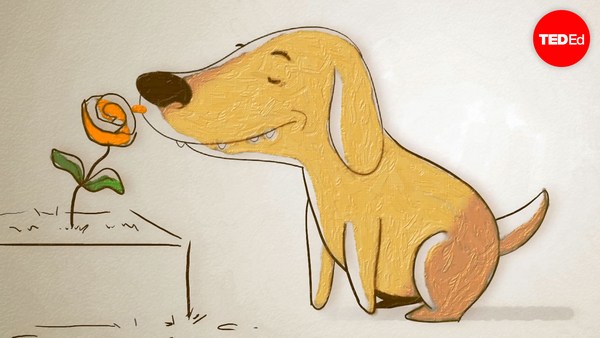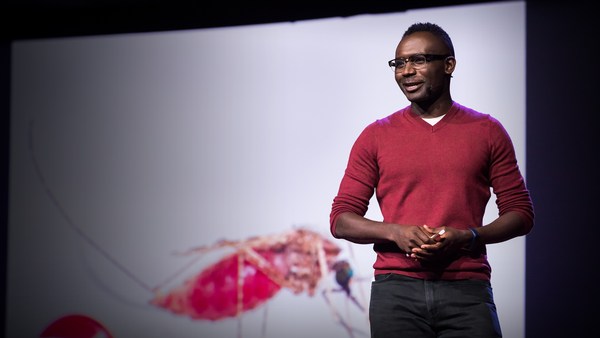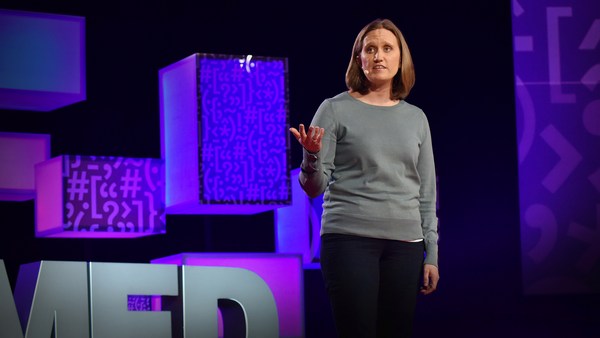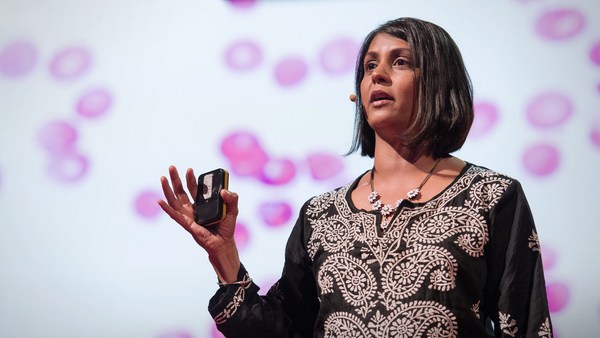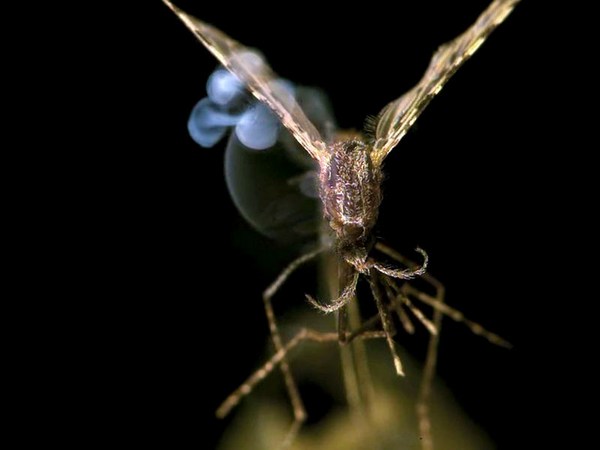Malaria is still one of the biggest killers on the planet. Despite us making significant progress in the last 20 years, half the world's population is still at risk from this disease. In fact, every two minutes, a child under the age of two dies from malaria. Our progress has undoubtedly stalled.
Now we face many challenges when it comes to tackling malaria, but one of the problems that we have is actually finding people who are infected with malaria in the first place. So, for example, if people have some level of immunity to the disease, then they can develop an infection and become infectious and still pass it on but not actually develop any symptoms, and that can be a big problem, because how do you find those people? It's like looking for a needle in a haystack. Now scientists have been trying to solve this problem for some years, but what I want to talk to you about today is that the solution to this problem may have been right under our noses this whole time.
Now that was a bit of a heavy start, with lots of really important statistics, so I want us all to just relax a little bit and that'll help me to relax a little bit as well. So why don't we just all take a nice deep breath in ... Wow. (Laughs)
And sigh, and, whoo, going to get blown away there. OK, now I want you to do it again, but this time, I want you to do it just through your nose, and I want you to really sense the environment around you. And in fact, I want you to really smell the person who's sitting next to you. Even if you don't know them, I don't care. Lean in, get your nose right into their armpit, come on, stop being so British about it, get your nose into the armpit, have a good old sniff, see what you can smell.
(Laughter)
Now each and every one of us would have had a very different sensory experience there. Some of us would have smelled something rather pleasant, perhaps somebody's perfume. But some of us might have smelled something a little bit less pleasant, perhaps somebody's bad breath or body odor. Maybe you even smelled your own body odor.
(Laughter)
But, you know, there's probably a good reason that some of us don't like certain body smells. Throughout history, there have been many examples of diseases being associated with a smell. So, for example, typhoid apparently smells like baked brown bread, and that's quite a nice smell, isn't it, but it starts to get a little bit worse. TB smells like stale beer, and yellow fever smells like the inside of a butcher shop, like raw meat. And in fact, when you look at the sort of words that are used to describe diseases, you tend to find these words: "rotting," "foul," "putrid" or "pungent." So it's no surprise, then, that smell and body odor gets a bit of bad reputation. If I was to say to you, "You smell," now, you're going to take that not exactly as a compliment, are you. But you do smell. You've just found that out. You do smell. It's a scientific fact.
And I'd quite like to turn that on its head. What if we could actually think about smell in a positive way, put it to good use? What if we could detect the chemicals that are given off by our bodies when we're ill, and use that to diagnose people? Now we'd need to develop good sensors that would allow us to do this, but it turns out that the world's best sensors actually already exist, and they're called animals.
Now animals are built to smell. They live their everyday lives according to their nose. They sense the environment, which tells them really important information about how to stay alive, essentially. Just imagine you're a mosquito and you've just flown in from outside and you've entered this room. Now you're going to be entering a really complex world. You're going to be bombarded with smells from everywhere. We've just found out that we're really smelly beasts. Each one of us is producing different volatile chemicals. It's not just one chemical, like BO -- lots and lots of chemicals. But it's not just you, it's the seats you're sitting on, the carpet, the glue that holds the carpet to the floor, the paint on the walls, the trees outside. Everything around you is producing an odor, and it's a really complex world that the mosquito has to fly through, and it has to find you within that really complex world. And each and every one of you will know -- Come on, hands up, who always gets bitten by mosquitoes? And who never gets bitten? There's always one or two really annoying people that never get bitten. But the mosquito has a really hard job to find you, and that's all to do with the way you smell. People who don't attract mosquitoes smell repellent, and what we know is that --
(Laughter)
I should clarify, repellent to mosquitoes, not to people.
(Laughter)
And what we know now is that that is actually controlled by our genes. But mosquitoes are able to do that because they have a highly sophisticated sense of smell, and they're able to see through all the, sort of, odor sludge to find you, that individual, and bite you as a blood meal.
But what would happen if one of you was infected with malaria? Well, let's just have a quick look at the malaria life cycle. So it's quite complex, but basically, what happens is a mosquito has to bite somebody to become infected. Once it bites an infected person, the parasite travels through the mouth part into the gut and then bursts through the gut, creates cysts, and then the parasites replicate, and then they make a journey from the gut all the way to the salivary glands, where they are then injected back into another person when the mosquito bites, because it injects saliva as it bites. Then, inside the human, it goes through a whole other cycle, a whole other part of the life cycle, so it goes through a liver stage, changes shape, and then comes out into the bloodstream again, and eventually, that person will become infectious. Now, one thing we know about the parasite world is that they are incredibly good at manipulating their hosts to enhance their own transmission, to make sure that they get passed onwards. If this was to happen in the malaria system, it might make sense that it would be something to do with odor that they manipulate, because odor is the key. Odor is the thing that links us between mosquitoes. That's how they find us. This is what we call the malaria manipulation hypothesis, and it's something that we've been working on over the last few years. So one of the first things that we wanted to do in our study was to find out whether an infection with malaria actually makes you more attractive to mosquitoes or not.
So in Kenya, with our colleagues, we designed an experiment where we had participants, children in Kenya, sleep inside tents. The odor from the tent was blown into a chamber which contained mosquitoes, and the mosquitoes would behaviorally respond. They would fly towards or fly away from the odors, depending on whether they liked them or not. Now some of the participants were infected with malaria, and some of them were uninfected, but importantly, none of the children had any symptoms whatsoever.
Now when we found and saw the results, it was really quite staggering. People who were infected with malaria were significantly more attractive than people who were uninfected. So let me explain this graph. We have "number of mosquitoes attracted to the child," and we have two sets of data: before treatment and after treatment. On the far left-hand side, that bar represents a group of people who are uninfected, and as we move towards the right-hand side, these people have become infected and they're moving towards the stage that they're infectious. So right at the stage when people are infectious is when they are significantly more attractive.
In this study, then, what we did is we obviously gave the children treatment to clear the parasites, and then we tested them again, and what we found was that highly attractive trait that was there disappeared after they had cleared the infection. So it wasn't just that the people were more attractive, it was that the parasite was manipulating its host in some way to make it more attractive to mosquitoes, standing out like a beacon to attract more mosquitoes so that it could continue its life cycle.
The next thing we wanted to do was find out what it was the mosquito was actually smelling. What was it detecting? So to do that, we had to collect the body odor from the participants, and we did this by wrapping bags around their feet, which allowed us to collect the volatile odors from their feet, and feet are really important to mosquitoes. They really love the smell of feet.
(Laughter)
Especially cheesy feet. Anybody got cheesy feet back there? Mosquitoes love that smell. So we focused on the feet, and we collected the body odor. Now when it comes to mosquitoes and olfaction, their sense of smell, it's very complex. It would be really nice if there was just one chemical that they detected, but it's not that simple. They have to detect a number of chemicals in the right concentration, the right ratios, the right combinations of chemicals. So you can sort of think about it like a musical composition. So, you know, if you get the note wrong or you play it too loud or too soft, it doesn't sound right. Or a recipe: if you get an ingredient wrong or you cook it too long or too little, it doesn't taste right. Well, smell is the same. It's made up of a suite of chemicals in the right combination.
Now our machines in the lab are not particularly good at picking out this sort of signal -- it's quite complex. But animals can, and what we do in my laboratory is we connect microelectrodes to the antennae of a mosquito. Imagine how fiddly that is.
(Laughter)
But what we also do is connect them to individual cells within the antennae, which is incredible. You don't want to sneeze when you're doing this, that's for sure. But what this does is it allows us to measure the electrical response of the smell receptors in the antennae, and so we can see what a mosquito is smelling.
So I'm going to show you what this looks like. Here's an insect's cell, and it will respond in a second when I press this button, and you'll see it sort of ticking over with this response. An odor will be blown over the cell, and it will go a bit crazy, sort of blow a raspberry, and then it will go back to its resting potential when we stop the odor.
(Rapid crackling)
(Low-pitch crackling)
(Rapid crackling)
OK, there we go, so you can go home now and say that you've seen an insect smelling and even hearing an insect smelling -- it's a weird concept, isn't it? But this works really well, and this allows us to see what the insect is detecting. Now using this method with our malaria samples, we were able to find out what the mosquito was detecting, and we found the malaria-associated compounds, mainly aldehydes, a group of compounds that smelled, that signified the malaria signal here. So now we know what the smell of malaria is, and we've used the mosquito as a biosensor to tell us what the smell of malaria actually is.
Now I'd like to imagine that you could, I don't know, put a harness on a little mosquito and put it on a lead and take it out and see if we can sniff people in a community -- that goes on in my head -- and see whether we could actually find people with malaria, but, of course, that's not really possible. But there is an animal that we can do that with.
Now dogs have an incredible sense of smell, but there's something more special about them: they have an ability to learn. And most of you people will be familiar with this concept at airports, where dogs will go down a line and sniff out your luggage or yourself for drugs and explosives or even food as well.
So we wanted to know, could we actually train dogs to learn the smell of malaria? And so we've been working with a charity called Medical Detection Dogs to see whether we can train them to learn the smell of malaria. And we went out to the Gambia and did some more odor collection on children that were infected and uninfected, but this time, we collected their odor by making them wear socks, nylon stockings, to collect their body odor. And we brought them back to the UK and then we handed them to this charity to run the experiment. Now I could show you a graph and tell you about that experiment works, but that'd be a bit dull, wouldn't it.
Now, they do say never work with children or animals live, but we're going to break that rule today. So please welcome onto the stage Freya ...
(Applause)
and her trainers Mark and Sarah.
(Applause)
Of course, this is the real star of the show.
(Laughter)
OK, so now what I'm going to ask is if you can all just be a little bit quiet, not move around too much. This is a very, very strange environment for Freya. She's having a good look at you guys now. So let's stay as calm as possible. That would be great. So what we're going to do here is basically, we're going to ask Freya to move down this line of contraptions here, and in each one of these contraptions, we have a pot, and in the pot is a sock that has been worn by a child in the Gambia. Now three of the socks have been worn by children who were uninfected, and just one of the socks was worn by a child who was infected with malaria. So just as you would see an airport, imagine these were people, and the dog is going to go down and have a good sniff. And let's see if you can see when she senses the malaria, and if she senses the malaria. This is a really tough test for her in this very strange environment, so I'm going to hand it over now to Mark.
(Laughs) Number three. OK.
(Applause)
There we go. I didn't know which pot that was in. Mark didn't know. This was a blind test, genuinely. Sarah, was that correct? Sarah: Yes.
JL: That was correct. Well done, Freya. That is fantastic. Whew.
(Applause)
That is really wonderful. Now Sarah is going to actually change the pots around a little bit, and she's going to take the one with malaria away, and we're just going to have four pots that are containing socks from children that had no malaria, so in theory, Freya should go down the line and not stop at all. And this is really important, because we also need to know people who are not infected, she needs to be able to do that. And this is a tough test. These socks have been in the freezer for a couple of years now, and this is a tiny bit of a sock as well. So imagine if this was a whole person, giving off a big signal. So this is really incredible. OK, over to you, Mark.
(Laughs)
(Applause)
Brilliant. Fantastic.
(Applause)
Really super. Thank you so much, guys. Big round of applause for Freya, Mark and Sarah. Well done, guys.
(Applause)
What a good girl. She's going to get a treat later. Fantastic.
So you've just seen that for your own eyes. That was a real live demonstration. I was quite nervous about it. I'm so glad that it worked.
(Laughter)
But it is really incredible, and when we do this, what we find is that these dogs can correctly tell us when somebody is infected with malaria 81 percent of the time. It's incredible. 92 percent of the time, they can tell us correctly when somebody does not have an infection. And those numbers are actually above the criteria set by the World Health Organization for a diagnostic. So we really are looking at deploying dogs in countries, and particularly at ports of entry, to detect people who have malaria. This could be a reality.
But we can't deploy dogs everywhere, and so what we're also looking to do and working on at the moment is the development of technology, wearable tech that would empower the individual to allow them to self-diagnose. Imagine a patch that you wear on the skin that would detect in your sweat when you're infected with malaria and change color. Or something a little more technical, perhaps: a smartwatch that would alert you when you're infected with malaria. And if we can do this digitally, and we can collect data, imagine the amount of data that we can collect on a global scale. This could completely revolutionize the way that we track the spread of diseases, the way that we target our control efforts and respond to disease outbreaks, ultimately helping to lead to the eradication of malaria, and even beyond malaria, for other diseases that we already know have a smell. If we can harness the power of nature to find out what those smells are, we could do this and make this a reality.
Now, as scientists, we're tasked with coming up with new ideas, new concepts, new technologies to tackle some of the world's greatest problems, but what never ceases to amaze me is that often nature has already done this for us, and the answer ... is right under our nose.
Thank you.
(Applause)
